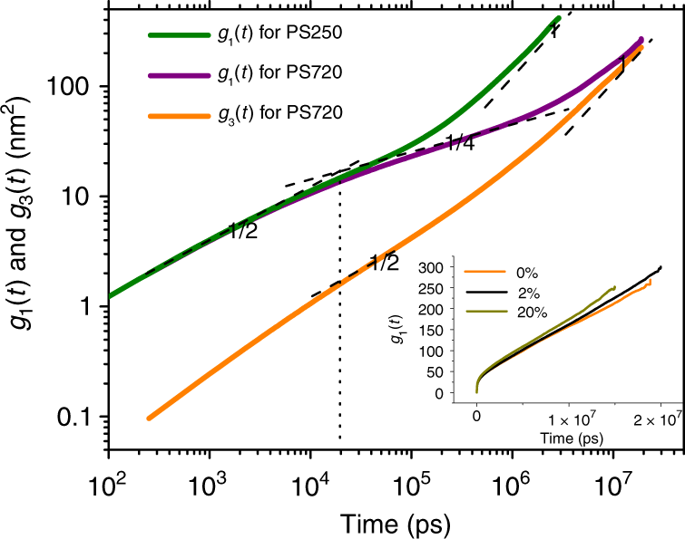当前位置:
X-MOL 学术
›
Nat. Commun.
›
论文详情
Our official English website, www.x-mol.net, welcomes your
feedback! (Note: you will need to create a separate account there.)
An unexpected N-dependence in the viscosity reduction in all-polymer nanocomposite.
Nature Communications ( IF 14.7 ) Pub Date : 2019-12-05 , DOI: 10.1038/s41467-019-13410-z Tao Chen 1 , Huan-Yu Zhao 1 , Rui Shi 1 , Wen-Feng Lin 1 , Xiang-Meng Jia 1 , Hu-Jun Qian 1 , Zhong-Yuan Lu 1 , Xing-Xing Zhang 2 , Yan-Kai Li 2 , Zhao-Yan Sun 2
Nature Communications ( IF 14.7 ) Pub Date : 2019-12-05 , DOI: 10.1038/s41467-019-13410-z Tao Chen 1 , Huan-Yu Zhao 1 , Rui Shi 1 , Wen-Feng Lin 1 , Xiang-Meng Jia 1 , Hu-Jun Qian 1 , Zhong-Yuan Lu 1 , Xing-Xing Zhang 2 , Yan-Kai Li 2 , Zhao-Yan Sun 2
Affiliation

|
Adding small nanoparticles (NPs) into polymer melt can lead to a non-Einstein-like decrease in viscosity. However, the underlying mechanism remains a long-standing unsolved puzzle. Here, for an all-polymer nanocomposite formed by linear polystyrene (PS) chains and PS single-chain nanoparticles (SCNPs), we perform large-scale molecular dynamics simulations and experimental rheology measurements. We show that with a fixed (small) loading of the SCNP, viscosity reduction (VR) effect can be largely amplified with an increase in matrix chain length [Formula: see text], and that the system with longer polymer chains will have a larger VR. We demonstrate that such [Formula: see text]-dependent VR can be attributed to the friction reduction experienced by polymer segment blobs which have similar size and interact directly with these SCNPs. A theoretical model is proposed based on the tube model. We demonstrate that it can well describe the friction reduction experienced by melt polymers and the VR effect in these composite systems.
中文翻译:

全聚合物纳米复合材料粘度降低中出乎意料的N依赖性。
将小纳米颗粒(NPs)添加到聚合物熔体中会导致非爱因斯坦样的粘度降低。但是,潜在的机制仍然是一个长期未解决的难题。在这里,对于由线性聚苯乙烯(PS)链和PS单链纳米颗粒(SCNP)形成的全聚合物纳米复合材料,我们进行大规模的分子动力学模拟和实验流变学测量。我们表明,在SCNP的固定(少量)负载下,随着基质链长度的增加,粘度降低(VR)效应可以大大增强[公式:请参见文本],而具有较长聚合物链的系统将具有更大的虚拟现实。我们证明了这种[公式:参见文本]依赖的VR可以归因于具有相似大小并直接与这些SCNP相互作用的聚合物链段团所经历的摩擦减小。在此基础上提出了一种理论模型。我们证明,它可以很好地描述熔融聚合物经历的摩擦降低以及这些复合材料系统中的VR效应。
更新日期:2019-12-05
中文翻译:

全聚合物纳米复合材料粘度降低中出乎意料的N依赖性。
将小纳米颗粒(NPs)添加到聚合物熔体中会导致非爱因斯坦样的粘度降低。但是,潜在的机制仍然是一个长期未解决的难题。在这里,对于由线性聚苯乙烯(PS)链和PS单链纳米颗粒(SCNP)形成的全聚合物纳米复合材料,我们进行大规模的分子动力学模拟和实验流变学测量。我们表明,在SCNP的固定(少量)负载下,随着基质链长度的增加,粘度降低(VR)效应可以大大增强[公式:请参见文本],而具有较长聚合物链的系统将具有更大的虚拟现实。我们证明了这种[公式:参见文本]依赖的VR可以归因于具有相似大小并直接与这些SCNP相互作用的聚合物链段团所经历的摩擦减小。在此基础上提出了一种理论模型。我们证明,它可以很好地描述熔融聚合物经历的摩擦降低以及这些复合材料系统中的VR效应。


















































 京公网安备 11010802027423号
京公网安备 11010802027423号